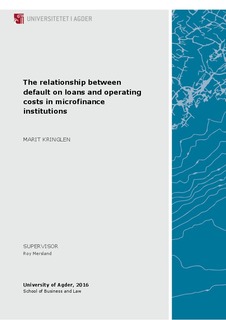| dc.contributor.author | Kringlen, Marit | |
| dc.date.accessioned | 2017-03-13T10:41:13Z | |
| dc.date.available | 2017-03-13T10:41:13Z | |
| dc.date.issued | 2016 | |
| dc.identifier.uri | http://hdl.handle.net/11250/2433930 | |
| dc.description | Master's thesis Business Administration BE501 - University of Agder 2016 | nb_NO |
| dc.description.abstract | One of the challenges in microfinance is to solve asymmetric information and cost concerns related to serving poor customers with little or no collateral, in order to offer poor people and small businesses access to financial services. In resent times the industry has been critiqued for maintaining harsh collection practices and charging too high interest rates to their clients. The microfinance mission of serving the poor has been questioned from several holds. There are sufficient previous studies that show that the interest rate to a great extent is driven by the operating costs in the institutions. Identifying the drivers of the operating costs thus becomes necessary in order to lower interest rates offered to the customers. The critique on collection practices is not uncalled for. Frequent collection of repayment is in the microfinance industry generally viewed as an essential component in reducing the risk of default, which historically has been a prominent goal of microfinance institutions due to the lack of collateral offered by their clients. The lack of credit history further adds to the need to manage risk, but with little background information allocation of resources becomes problematic. Transaction costs are therefore high in the industry.
It is a paradox that the world’s poorest are charged with the highest cost of capital, and the industry faces a need for lower interest rates in order to help more people. This study investigates the relationship between default rates and operating costs in the microfinance sector, and looks into whether the microfinance sector over time has been too concerned with lowering default rates. Has the focus on default rates left the microfinance institutions with too high operating costs due to extensive transaction costs connected to monitoring, control and collection practices? Would they be better off by allowing for higher levels of default and lower transaction costs? | nb_NO |
| dc.language.iso | eng | nb_NO |
| dc.publisher | Universitetet i Agder ; University of Agder | nb_NO |
| dc.rights | Attribution-NonCommercial-NoDerivatives 4.0 Internasjonal | * |
| dc.rights.uri | http://creativecommons.org/licenses/by-nc-nd/4.0/deed.no | * |
| dc.subject | BE501 | nb_NO |
| dc.title | The relationship between default on loans and operating costs in microfinance institutions | nb_NO |
| dc.type | Master thesis | nb_NO |
| dc.subject.nsi | VDP::Samfunnsvitenskap: 200::Økonomi: 210::Bedriftsøkonomi: 213 | nb_NO |
| dc.source.pagenumber | 112 p. | nb_NO |

